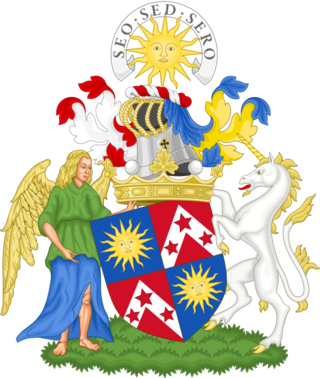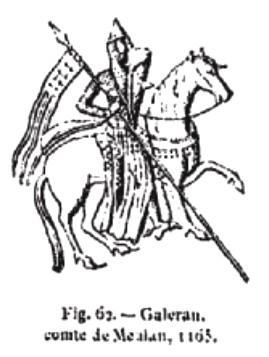
The Earldom of Warrington is a title which has been created twice in British history, in 1690 and 1796. For information on the 1690 creation, see Booth baronets. For information on the 1796 creation, see Earl of Stamford.

The Earldom of Warrington is a title which has been created twice in British history, in 1690 and 1796. For information on the 1690 creation, see Booth baronets. For information on the 1796 creation, see Earl of Stamford.

Earl of Pembroke is a title in the Peerage of England that was first created in the 12th century by King Stephen of England. The title, which is associated with Pembroke, Pembrokeshire in West Wales, has been recreated ten times from its original inception. Due to the number of creations of the Earldom, the original seat of Pembroke Castle is no longer attached to the title.
There are currently two earldoms of Mar in the Peerage of Scotland, and the title has been created seven times. The first creation of the earldom is currently held by Margaret of Mar, 31st Countess of Mar, who is also clan chief of Clan Mar. The seventh creation is currently held by James Erskine, 14th Earl of Mar and 16th Earl of Kellie, who is also clan chief of Clan Erskine.

Marquess of Lothian is a title in the Peerage of Scotland, which was created in 1701 for Robert Kerr, 4th Earl of Lothian. The Marquess of Lothian holds the subsidiary titles of Earl of Lothian, Earl of Lothian, Earl of Ancram (1633), Earl of Ancram, Viscount of Briene (1701), Lord Newbattle (1591), Lord Jedburgh (1622), Lord Kerr of Newbattle (1631), Lord Kerr of Nisbet, Langnewtoun, and Dolphinstoun (1633), Lord Kerr of Newbattle, Oxnam, Jedburgh, Dolphinstoun and Nisbet (1701), and Baron Ker, of Kersheugh in the County of Roxburgh (1821), all but the last in the Peerage of Scotland. As The Lord Ker in the Peerage of the United Kingdom, previous marquesses sat in the House of Lords before 1963, when Scottish peers first sat in the House of Lords in their own right. The holder of the marquessate is also the Chief of Clan Kerr.

Earl of Nottingham is a title that has been created seven times in the Peerage of England. It was first created for John de Mowbray in 1377, at the coronation of Richard II. As this creation could only pass to his legitimate heirs, it went extinct on his death in 1383. It was re-created for his younger brother Thomas de Mowbray in the same year, however. This branch of the family became Dukes of Norfolk, and the title would descend with them until John de Mowbray died without male heirs in 1476.

Earl of Melville is a title in the Peerage of Scotland. It was created in 1690 for the Scottish soldier and statesman George Melville, 4th Lord Melville. He was made Lord Raith, Monymaill and Balwearie and Viscount of Kirkcaldy at the same time, also in the Peerage of Scotland. He married Catherine Leslie, daughter of Alexander Leslie, Lord Balgonie, and granddaughter of Alexander Leslie, 1st Earl of Leven. Lord Melville was succeeded upon his death in 1707 by his eldest surviving son, David, who already in 1681 had succeeded to the earldom of Leven through his mother. The two earldoms have since remained united. For further history of the titles, see Earl of Leven.

Earl of Annandale and Hartfell is a title in the Peerage of Scotland, created in 1661 for James Johnstone.

Earl of Stair is a title in the Peerage of Scotland. It was created in 1703 for the lawyer and statesman John Dalrymple, 2nd Viscount of Stair.
Earl of March is a title that has been created several times, respectively, in the Peerage of Scotland and the Peerage of England. The title derives from the "marches" or borderlands between England and either Wales or Scotland, and it was held by several great feudal families which owned lands in those districts. Later, however, the title came to be granted as an honorary dignity, and ceased to carry any associated power in the marches.

Earl of Guilford is a title that has been created three times in history. The title was created for the first time in the Peerage of England in 1660 for Elizabeth Boyle. She was a daughter of William Feilding, 1st Earl of Denbigh, and the widow of Lewis Boyle, 1st Viscount Boyle of Kinalmeaky. The title was for life only and became extinct on her death in 1667. The title was created for a second time in the Peerage of England in 1674 for John Maitland, 1st Duke of Lauderdale. For more information on this creation, see the article on him as well as the Earl of Lauderdale.

Earl of Mansfield, in the County of Nottingham, and Earl of Mansfield, in the County of Middlesex, are two titles in the Peerage of Great Britain that have been united under a single holder since 1843.

Earl of Carnarvon is a title that has been created three times in British history. The current holder is George Herbert, 8th Earl of Carnarvon. The town and county in Wales to which the title refers are historically spelled Caernarfon, having been Anglicised to Carnarvon or Caernarvon. The traditional Welsh spelling is itself a modified form of the original name of antiquity, Caer-yn-Arfon, meaning fortification opposite the island of Mona.

Earl of Liverpool is a title that has been created twice in British history. The first time was in the Peerage of Great Britain in 1796 for Charles Jenkinson, 1st Baron Hawkesbury, a favourite of King George III. He had already been made Baron Hawkesbury, of Hawkesbury in the County of Gloucester, in 1786, and had succeeded as seventh Baronet of Walcot and Hawkesbury in 1790. His eldest son, the second Earl, served as Prime Minister of the United Kingdom from 1812 to 1827. The peerages became extinct in 1851 on the death of the latter's half-brother, the third Earl, while the baronetcy was inherited by a cousin.

Earl of Anglesey was a title in the Peerage of England during the 17th and 18th centuries.

Earl of Worcester is a title that has been created five times in the Peerage of England. Worcester is a cathedral city in Worcestershire, England.

Viscount Newark is a title that has been created twice in British history, each time with the subsidiary title of Baron Pierrepont.

Earl of Londonderry is a title that has been created three times in the Peerage of Ireland. The first creation came in 1622 in favour of Thomas Ridgeway, 1st Baron Ridgeway, who served as Treasurer of Ireland and was involved in the colonisation of Ulster. He had already been created a Baronet, of Torrington in the County of Devon, in 1611, Lord Ridgeway, Baron of Gallen-Ridgeway, in the Peerage of Ireland, in 1616, and was made Viscount Gallen-Ridgeway at the same time as he was granted the earldom, also in the Peerage of Ireland. The titles became extinct on the death of his great-grandson, the fourth Earl, in 1714.

Earl of Sussex is a title that has been created several times in the Peerages of England, Great Britain, and the United Kingdom. The early Earls of Arundel were often also called Earls of Sussex.

There have been three baronetcies created for persons with the surname Booth, one in the Baronetage of England and two in the Baronetage of the United Kingdom. The 1916 creation remains extant, the 1835 creation became extinct in 1896 and the 1611 baronetcy has been dormant since 1797. The senior line of the first creation was elevated to the peerage as Baron Delamer and Earl of Warrington.

Earl of Stamford was a title in the Peerage of England. It was created in 1628 for Henry Grey, 2nd Baron Grey of Groby. This Grey family descended through Lord John Grey, of Pirgo, Essex, younger son of Thomas Grey, 2nd Marquess of Dorset, and younger brother of Henry Grey, 1st Duke of Suffolk ; Suffolk was executed for treason in 1554 forfeiting his titles.
There have been four creations of the title Baron Lumley, all in the Peerage of England: